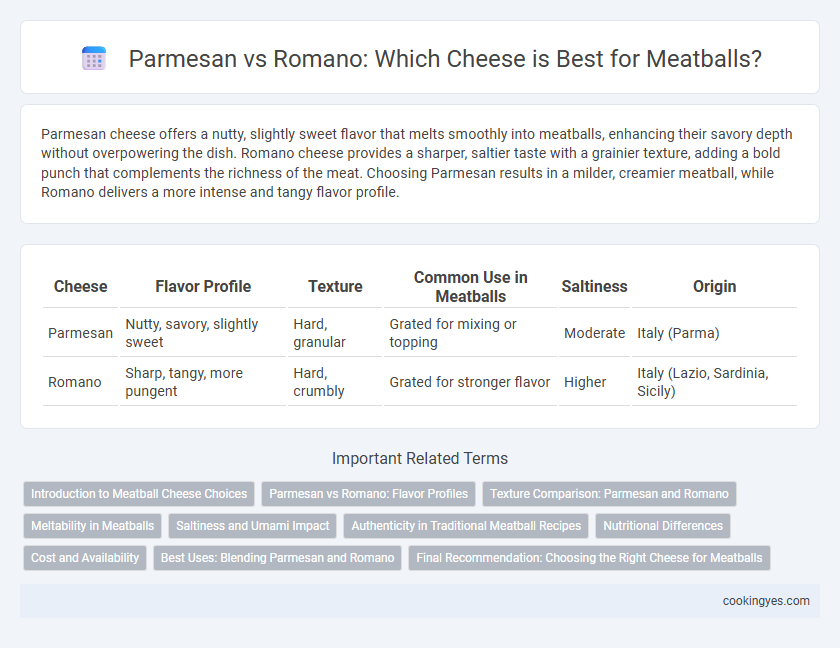Parmesan cheese offers a nutty, slightly sweet flavor that melts smoothly into meatballs, enhancing their savory depth without overpowering the dish. Romano cheese provides a sharper, saltier taste with a grainier texture, adding a bold punch that complements the richness of the meat. Choosing Parmesan results in a milder, creamier meatball, while Romano delivers a more intense and tangy flavor profile.
Table of Comparison
| Cheese | Flavor Profile | Texture | Common Use in Meatballs | Saltiness | Origin |
|---|---|---|---|---|---|
| Parmesan | Nutty, savory, slightly sweet | Hard, granular | Grated for mixing or topping | Moderate | Italy (Parma) |
| Romano | Sharp, tangy, more pungent | Hard, crumbly | Grated for stronger flavor | Higher | Italy (Lazio, Sardinia, Sicily) |
Introduction to Meatball Cheese Choices
Parmesan and Romano cheeses are popular choices for enhancing meatball flavor and texture, each offering distinct qualities. Parmesan provides a nutty, mild taste with a granular texture that melts smoothly into the meat mixture, while Romano delivers a sharper, saltier flavor with a firmer consistency that adds a bold punch. Selecting between Parmesan and Romano depends on the desired flavor intensity and regional authenticity in classic meatball recipes.
Parmesan vs Romano: Flavor Profiles
Parmesan cheese offers a nutty and slightly sweet flavor with a granular texture that melts smoothly into meatballs, enhancing their savory richness. Romano cheese delivers a sharper, saltier, and more robust taste, adding a bold punch that complements the spices in meatball recipes. Choosing Parmesan provides a milder, creamier cheese profile, while Romano brings a distinctive piquancy that intensifies the overall flavor experience.
Texture Comparison: Parmesan and Romano
Parmesan cheese offers a granular and slightly crystalline texture that melts smoothly into meatball mixtures, enhancing moisture retention and creating a tender bite. Romano cheese provides a coarser, sharper texture that adds a more pronounced, crumbly element, contributing to a meatball's rustic firmness. Texture differences influence the final mouthfeel, with Parmesan producing creamier meatballs, while Romano lends a denser, more textured finish.
Meltability in Meatballs
Parmesan cheese offers a creamy meltability that enhances the texture of meatballs, creating a smooth, cohesive interior. Romano cheese, while sharper and saltier, tends to retain more texture when melted, contributing a firmer bite within the meatball. Choosing Parmesan emphasizes a softer, more integrated melt, whereas Romano provides a distinct cheesy crunch in every bite.
Saltiness and Umami Impact
Parmesan cheese enhances meatballs with a balanced saltiness and rich umami flavor, creating a savory depth that complements the meat's natural taste. Romano cheese offers a sharper, saltier profile, intensifying the meatball's seasoning but can overshadow subtle flavors if used excessively. Choosing between Parmesan and Romano depends on desired saltiness and umami impact, with Parmesan providing a milder, more nuanced umami boost.
Authenticity in Traditional Meatball Recipes
Parmesan cheese is traditionally preferred in authentic Italian meatball recipes for its nutty flavor and fine texture that melts smoothly, enhancing the dish's richness. Romano cheese, made from sheep's milk, offers a sharper and saltier taste, which can overpower the subtle balance of classic meatball seasonings. Using Parmesan aligns with authentic regional cooking practices, maintaining the genuine flavor profile cherished in traditional meatball preparations.
Nutritional Differences
Parmesan cheese contains higher levels of calcium and protein compared to Romano, contributing to stronger bones and muscle repair in meatball recipes. Romano cheese has a sharper, saltier taste but typically contains less fat and fewer calories, making it a leaner choice for those monitoring dietary intake. Both cheeses provide essential nutrients like phosphorus and vitamins A and B12, but Parmesan's slightly lower sodium content supports heart health better in meatball preparations.
Cost and Availability
Parmesan cheese generally costs more than Romano, making Romano a budget-friendly choice for meatball recipes. Parmesan is widely available in grocery stores and often sold pre-grated, while Romano's availability can be more limited but is still found in most supermarkets. Choosing Romano can reduce costs slightly without sacrificing the sharp, salty flavor crucial for authentic meatballs.
Best Uses: Blending Parmesan and Romano
Parmesan offers a nutty, slightly sweet flavor, while Romano provides a sharper, saltier taste, making their blend ideal for meatballs. Combining these cheeses enhances depth and complexity, balancing richness with tanginess for a perfectly seasoned meatball mixture. Using a blend of two parts Parmesan to one part Romano achieves a savory balance that complements both the meat and herbs.
Final Recommendation: Choosing the Right Cheese for Meatballs
Parmesan offers a nutty, slightly sweet flavor and melts smoothly, enhancing the rich taste and texture of meatballs. Romano delivers a sharper, saltier bite with a crumbly texture that adds a bolder, tangier dimension to the dish. For classic Italian-style meatballs, Parmesan is recommended for its balanced taste and creamy melt, while Romano suits those seeking a more intense, savory punch.
Parmesan vs Romano for meatball cheese Infographic

 cookingyes.com
cookingyes.com